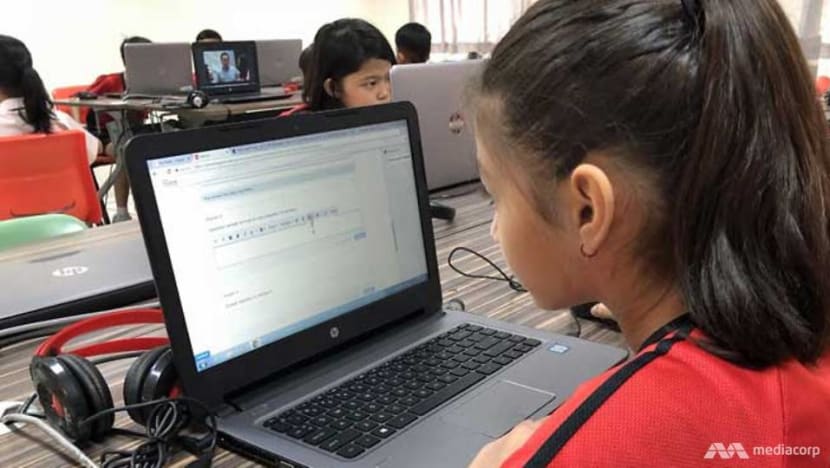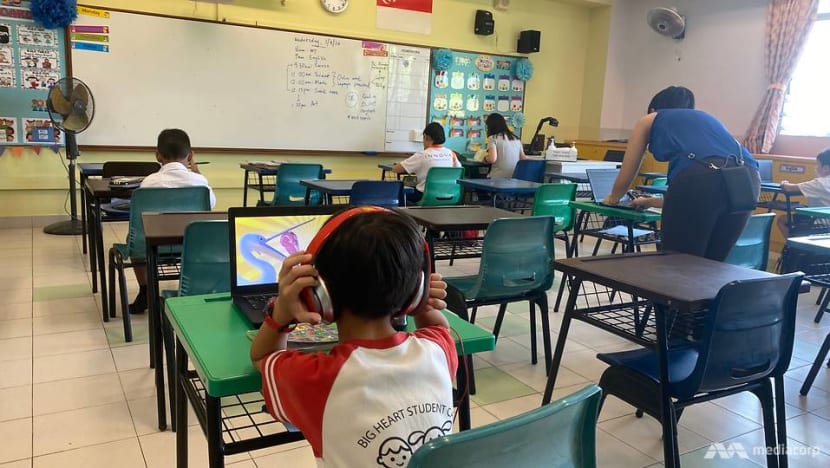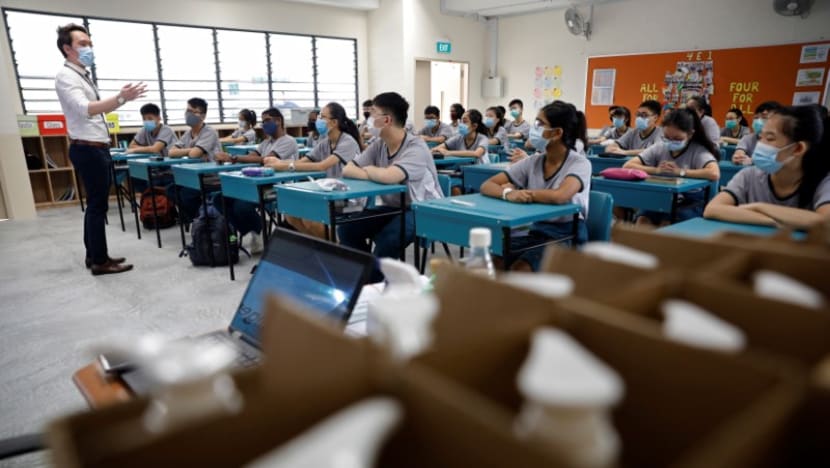commentary Commentary
Commentary: Laptops for every student – a lot could go wrong
Issues with distraction and unsafe content are real and safeguards must be in place before every student is given a digital device, says Professor Lim Sun Sun of SUTD.

The Singapore Student Learning Space (SLS) was piloted at 62 primary and secondary schools in August 2017. (Photo: Tan Si Hui)
SINGAPORE: So we are giving all secondary school students in Singapore personal laptops. What could possibly go wrong?
In short, a great deal.
Former Minister for Education Ong Ye Kung first announced at the Committee of Supply debate in March this year that Singapore planned to launch a device ownership scheme to ensure that all Secondary 1 pupils will be issued personal laptops by 2028.
Intended to help pupils use software and devices to better exploit digital learning, the devices will either come heavily subsidised or free depending on the students’ socioeconomic background.
This narrative saw a sudden twist in the wake of Singapore’s circuit breaker when schools had to pivot abruptly to home-based learning.
Overnight, digital access divides across the student population were drawn into sharp relief, with children in lower-income households either lacking devices or owning devices ill-suited to home-based learning.
READ: MOE to review how to 'blend' classroom and digital online learning as schools reopen after COVID-19 circuit breaker
Inadequacy of home Internet access was yet another issue. The Ministry of Education responded by loaning out 12,500 laptops or tablets and 1,200 Internet enabling devices including dongles by mid-April.
Ground efforts by the likes of Engineering Good and Touch Community Services also stepped in with such support.

In June, Senior Minister Tharman Shanmugaratnam shared in his ministerial broadcast that the scheme to equip all secondary school students with laptops would be accelerated by seven years with 2021 being the revised target.
He set this announcement within the context of reaffirming the government’s commitment to ensuring social mobility for Singaporeans from all walks of life, noting that “(m)any occupations are being transformed by the digital revolution and other technological advances.”
In a rapidly technologising world therefore, digital literacy is fast becoming a basic survival skill. By providing every secondary school student with a laptop or tablet, we will indeed help to level the playing field for acquiring digital literacy.
ANXIETIES FROM DEVICES
Even so, concerns have been raised about this initiative, ranging from fears of students being constantly distracted, addicted to devices and abusing them for inappropriate or even harmful content heavy in violence, sexual explicitness and ideological extremism, or that encourages illegal or anti-social behaviour.
These anxieties are not entirely misplaced, and nor should we attribute them only to the stodgy Luddites among us. As every parent knows, devices and the digital content they offer can often be too much of a good thing.
The interactivity, multimedia content, immersive environments and instant gratification offered by the online world attract and captivate us.
Yet the qualities that make online learning highly engaging are the same ones that make it difficult to stop scrolling endlessly through Instagram feeds, or to break free from World of Warcraft.

Once we have armed all students with personal devices therefore, how can we ensure that we maximise benefits and minimise harms?
Students’ ability to focus on lessons is clearly an issue. During his Committee of Supply speech, Mr Ong noted that one lesson gleaned from a pilot trial was the need for “controlled access so that the device is used for education and learning, and not other distractions!”
Indeed a study by the Massachusetts Institute of Technology found that banning laptops raised the exam performance of students in a military academy whereas research by the London School of Economics concluded that banning mobile phones in classrooms helped low-achieving students improve.
One important caveat about both studies is that neither was set in a context where devices were being used for the express purpose of classroom instruction.
CONSTRUCTING DIGITAL SCAFFOLDS
When used strategically for teaching however, devices in classrooms can make learning highly engaging and participatory.
Students can take part in online polls, complete pop quizzes to receive instant feedback or enter virtual environments that bring textbook illustrations to life.
The online learning environment can also feel less intimidating for students and offer a safer space to ask questions, express doubts or assert less conventional views.
READ: Commentary: It is time to rethink how we do online education
LISTEN: Home-based learning: Good, bad, terrible ...but mostly good?
There are thus considerable virtues we can harness from digital learning.
Having taken the bold decision to incorporate devices into our classrooms for digitally-enabled learning, Singapore must therefore consciously and carefully build in the critical scaffolding for this endeavour to succeed.
Our teachers cannot be expected to navigate this new environment on their own but must be upskilled to fully exploit the device-rich classroom and empowered to tackle disciplinary issues that may emerge from students’ misuse of devices.

Of course, they need to be supported by the wealth of digital classroom management tools that grant teachers control over students’ computers, allowing them to display lessons, grade work, view workstation progress and lock out particular users.
Schools must be also be boosted with well-resourced and more nimble educational technology support teams.
Besides providing higher-level guidance to help teachers refine their digital pedagogy, such teams will also have to offer more mundane hardware support for students when their devices malfunction or require upgrading.
We cannot assume that all students will be equally adept at using and maintaining their devices, or enjoy parental support in this regard.
READ: Home-based learning blues: Life in a rental flat during the COVID-19 circuit breaker
Which leads us finally to the students’ home environments.
WHY HOME ENVIRONMENTS ARE CRITICAL
Personally-owned laptops will be toted to and from home where after-school use by students will present its own challenges.
In households with better-educated parents who can actively supervise their children’s device use to support their learning, these devices’ potential for learning enhancement will be further boosted.
For lower-income households where parents may lack the digital competencies or even time to be more hands on, the children will be literally left to their own devices.

We must do our best to ensure that all parents understand the importance of oversight and mediation of their children’s technology use, and provide them with the knowledge and skills for doing so through community- or school-based training programmes.
Fundamentally, when we take the monumental step of equipping every student with a device, we must also bear the responsibility for the consequences, be they salutary or adverse.
Vesting our students with technological tools is a laudable and necessary move as we advance towards a digitalising future. But let us also ensure that essential safeguards be put in place and support structures well established too.
Returning to my opening question, a lot could indeed go wrong with giving every student a device. Nevertheless, we can anticipate and mitigate potential problems by paving the path to digital learning with more than just laptops.
Lim Sun Sun is Professor of Communication and Technology and Head of Humanities, Arts and Social Sciences at the Singapore University of Technology and Design. She recently published Transcendent Parenting - Raising Children in the Digital Age (Oxford University Press, 2020). She was named to the inaugural Singapore 100 Women in Tech list in 2020 for her pioneering research on the social impact of technology.














